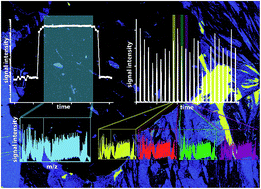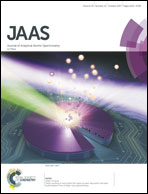Capabilities of laser ablation inductively coupled plasma time-of-flight mass spectrometry†
Abstract
In this paper, we characterize an inductively coupled plasma time-of-flight mass spectrometry (ICP-TOFMS) instrument (icpTOF, TOFWERK AG, Thun, Switzerland) in combination with laser-ablation sample introduction. Three sample introduction approaches for LA-based ICP-TOFMS analysis are described: (1) steady-state LA with a conventional high-dispersion LA cell, (2) single-pulse analysis with large spot sizes (44 μm diameter) using a low-dispersion LA cell, and (3) pulse-resolved, high-speed, high-resolution (5 μm spot sizes) elemental imaging with the same low-dispersion LA cell. These sample-introduction schemes span the range of approaches most interesting for users of LA-ICP-TOFMS, from routine bulk quantification, to low-sample-consumption trace-element analysis, to demanding elemental imaging applications. From steady-state signal intensities, element concentrations in NIST SRM 612 and USGS BCR-2G were quantified within the uncertainty range of the preferred values when NIST SRM 610 was used as the external reference material. Relative deviations were less than 10% in most cases. When using a 44 μm diameter spot and a laser repetition rate of 10 Hz, limits of detection (LODs) were in the single digit ng g−1 range for the most sensitive isotopes. Isotope-ratio precision was in the sub per mill regime and governed by counting statistics. Similar accuracies were also achieved in low-dispersion LA-ICP-TOFMS experiments, when NIST SRM 612 and USGS BCR-2G element concentrations were quantified using signal intensities from single 44 μm diameter laser pulses. LODs were in the tens of ng g−1 range for most sensitive isotopes resulting in absolute LODs in the tens of attograms. Capabilities of the icpTOF for elemental imaging are demonstrated with pulse-resolved multi-elemental imaging of a multi-phase geological thin section. With the low-dispersion LA cell and a spot diameter of 5 μm, aerosol plumes were confined to less than 10 ms, which allowed elemental imaging at a laser repetition rate of 100 Hz with minimized pulse-to-pulse mixing and an adjacent-pixel dynamic range of greater than 102. Quantitative results for elements of major, minor and trace concentrations were in agreement with bulk composition of individual regions, which had been determined via petrographic microscopy and high-dispersion laser ablation inductively coupled plasma quadrupole mass spectrometry (LA-ICPQMS). LODs were in the single digit μg g−1 range for most sensitive isotopes.



 Please wait while we load your content...
Please wait while we load your content...